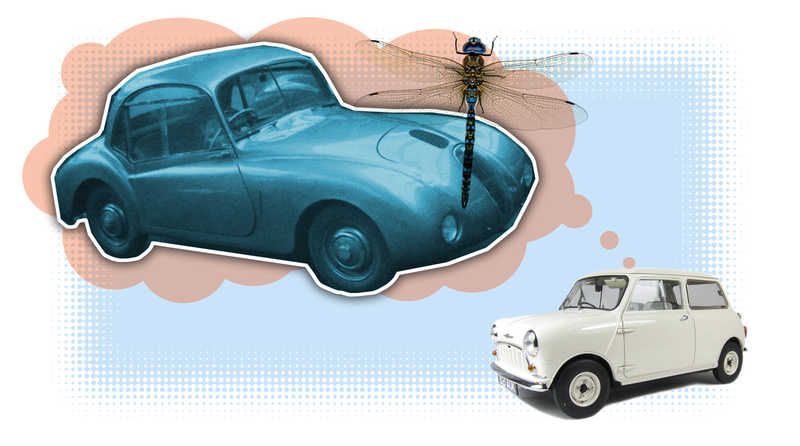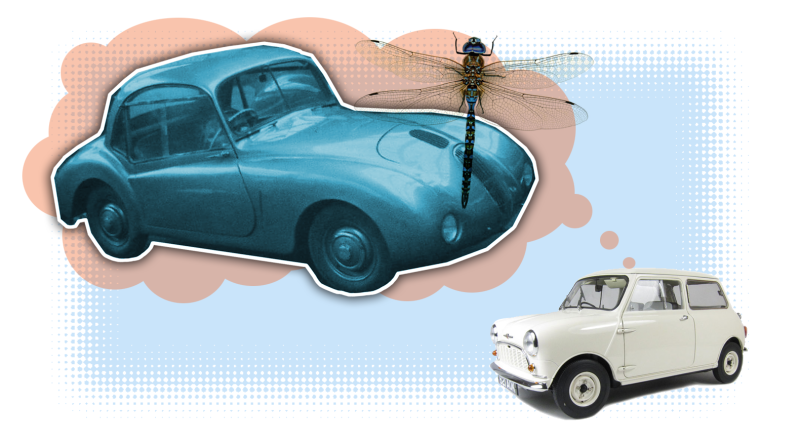
The original BMC Mini is widely considered to be one of the most technically influential cars of all time. Its transverse front-wheel drive layout is the basic design of nearly all mass-market small cars to this day. Yet a surprising number of the Mini’s revolutionary design decisions were present in another tiny car 13 years earlier. There was only one prototype, and the strangely adorable little car is largely forgotten: the Duncan Dragonfly.
Ian Duncan was an engineer, and had worked for the Bristol airplane company and at least one other automotive venture that will be the subject of a future article. In 1946 he moved to help his brother build canning machinery for his canning company in North Walsham, England.
Once there, he must have found canning machinery less than fully stimulating, because he soon established a carmaking company called Duncan Industries, which was headquartered in an old building full of several tons of spoiled curry.
The curry was cleaned out, a machine shop was set up, and Duncan went into business, and their first revenue-creating products were special-bodied versions of Healeys (as in what would later be Austin-Healey) and Alvis cars.
Advertisement
While the Duncan Healeys and Duncan Alvises were what kept things going, what Duncan really wanted to do was to develop a revolutionary small car. Duncan and a small team of very creative engineers began work on their small car, which they wanted to be capable of carrying three people efficiently and in relative comfort.
The design decisions they made are remarkably like the ones Alec Issigonis made when developing the Mini, right from the start. The Mini famously used special 10-inch wheels that required custom tires from Dunop in order to maximize the car’s interior space. The Dragonfly was designed to have 12-inch wheels, which were initially ordered from Crosley in America, but later Dunlop was asked to make the wheels and tires, just like they would be asked by the Austin for the Mini 13 years later.
Advertisement
The Dragonfly’s engine was different than the Mini’s, and was a 500cc air-cooled twin from BSA. Like the Mini, though, it was designed to drive the front wheels, and the transmission was designed to be a unit with the engine, predicting the Mini’s later gearbox-in-sump approach.
Unlike the Mini, the Dragonfly mounted its engine longitudinally, in front of the the front axle, driving CV joints via chain. The arrangement is sort of like an old DKW.
Advertisement
Also incredibly Mini-like is the suspension, which isn’t just similar to what the Mini would later use, but is pretty much the direct ancestor of the same rubber-based hydrolastic suspension system, designed by the same man, Alex Moulton.
This suspension design was incredibly space-saving, which was why it was later employed in Issigonis’ Mini designs.
Advertisement
The body design, though, couldn’t have been less like the Mini even if the Mini team from 1959 traveled back in time to make sure nobody would see these two cars as similar in any way. Where the Mini was a very rational, space-maximizing two-box design, the Dragonfly had a rounded-shoe look like a miniaturized version of Duncan’s larger sporting cars, with a long hood, short rear deck, and extravagant curves.
This basic design, which sort of feels like an old Jaguar XK120, had to be modified when shrunken, and as a result the proportions of the greenhouse are much larger in comparison to the rest of the car, giving the same sort of effect as the comparatively big forehead of a baby. It looks like a cute little puppy version of a car.
Advertisement
The large greenhouse also forced a very strange side window arrangement, with a square-ish roll-down window area crowned with a narrow, elongated semicircle of glass. I’ve never seen another car with a door glas design quite like this.
The Dragonfly prototype was a really remarkable little car. It was tested extensively, and the little 1,064 pound car was able to hit 65 MPH with its tiny motor. While it seemed quite promising, tax issues forced Duncan to close its doors around 1948, and Duncan sold the Dragonfly prototype to Austin and went to work there himself.
Duncan left Austin in 1951, and the Dragonfly had been put into storage and later cut up for scrap. But, eight years later, the Austin Mini hit the scene, and in it were many ideas first pioneered by another strangely cute little car.













